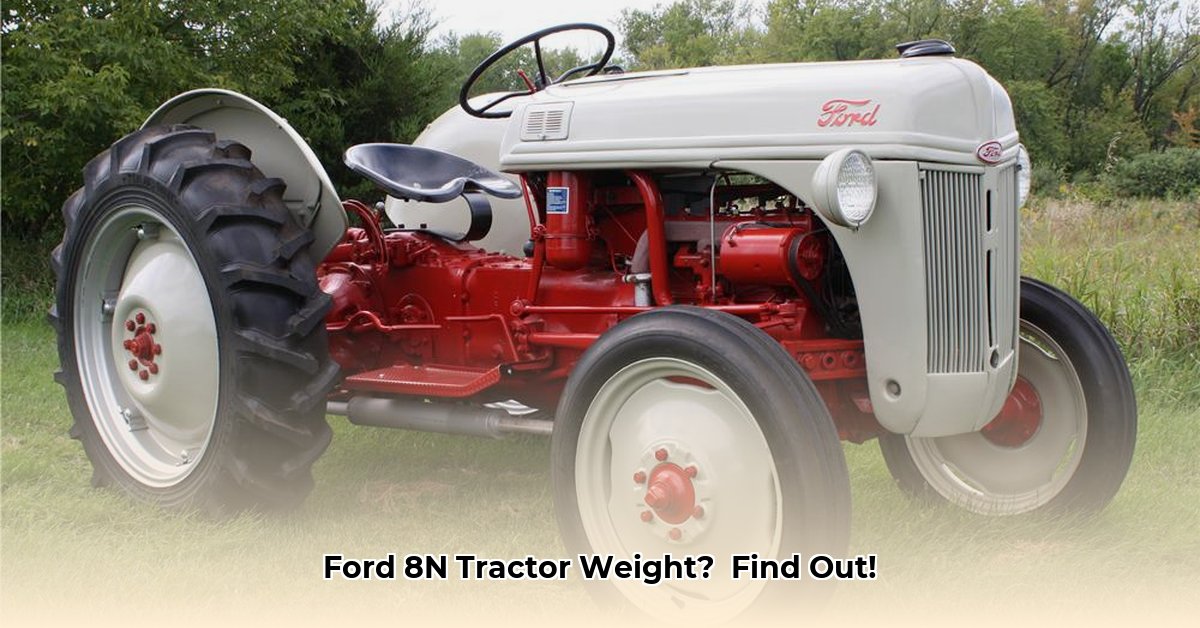
Determining the Weight of a Ford 8N Tractor
The weight of a Ford 8N tractor isn't a single, definitive number. Several factors influence its weight, making a precise answer dependent on the specific tractor's condition and modifications. Understanding these variables is crucial for safe operation, transportation, and even soil health considerations. For more information on Ford tractor types, see this helpful resource.
Factors Affecting Ford 8N Tractor Weight
Several key factors contribute to the overall weight of a Ford 8N:
Modifications: Original, unmodified tractors will weigh less than those customized with added features like front-end loaders or heavier replacement parts. These modifications can significantly alter the tractor's overall weight.
Fuel Level: A full fuel tank adds considerable weight, often hundreds of pounds. An empty tank results in a significantly lighter tractor.
Fluid Levels: Engine oil, transmission fluid, and hydraulic fluids contribute to the total weight. Full fluid levels increase the weight compared to low levels.
Attachments: Attached implements, such as plows or cultivators, substantially increase the overall weight of the tractor and its operational capacity.
Estimated Weight Range
Considering these variables, a reasonable estimate for the weight of a Ford 8N tractor is between 2,500 and 3,000 pounds (1134 and 1361 kilograms). This is a broad range, highlighting the importance of considering individual tractor variations.
Did you know that even the fluids within the tractor contribute to its weight and overall operational efficiency? Proper fluid maintenance is vital for both performance and safety.
The Importance of Knowing Your Ford 8N's Weight
Understanding your Ford 8N's weight is essential for several practical reasons:
Safety: Accurate weight knowledge is crucial for safe operation, especially on uneven terrain or when crossing bridges. Overloading a structure could lead to significant danger.
Transportation: Weight significantly impacts transportation planning and costs. Choosing the appropriate trailer and ensuring its capacity can handle the load (including the tractor's weight and any attached implements) guarantees safe transport.
Soil Compaction: Heavier tractors can cause greater soil compaction, impacting water infiltration and overall soil health. This is a crucial factor in sustainable agricultural practices.
Maintenance: Knowing the weight aids mechanics in diagnosing problems and using appropriate equipment during maintenance and repair. This contributes to efficient and effective service.
A heavier tractor, for example, might require more powerful lifting equipment during repairs. Proper weight assessment simplifies the maintenance process.
The Ford 8N and Sustainable Agriculture
The Ford 8N, while revolutionary for its time, presents a complex legacy within the context of modern sustainable agriculture. Its fuel efficiency, relatively high compared to modern tractors, is a key consideration.
Comparing Fuel Efficiency to Modern Tractors
Modern tractors have outpaced the Ford 8N in fuel efficiency. Advancements in engine technology, improved transmissions, and computer-controlled fuel injection systems have created significant improvements in fuel economy and reduced emissions. This difference reflects technological advancements in the pursuit of sustainable agriculture.
What impact do these fuel efficiency improvements have on the environment? Reduced fuel consumption directly equates to lower greenhouse gas emissions, a critical factor in modern sustainable farming practices.
Key Specifications (Approximate)
| Specification | Value | Notes |
|---|---|---|
| Weight | 2,500 - 3,000 lbs (1134 - 1361 kg) | Estimated range; varies based on factors discussed above. |
| Engine Type | Four-cylinder, gasoline | |
| Horsepower (PTO) | Approximately 27 hp | Power Take-Off Horsepower |
| Fuel Consumption | Relatively high (for its time) | A significant factor in comparing it to modern, more fuel-efficient alternatives. |
Knowing the weight of your Ford 8N tractor is not just a matter of curiosity; it is a critical factor impacting safety, transportation planning, soil health, and the overall efficiency of your farming operations. Furthermore, understanding the tractor’s historical context and its limitations concerning modern sustainability standards helps guide future equipment choices and farming practices.